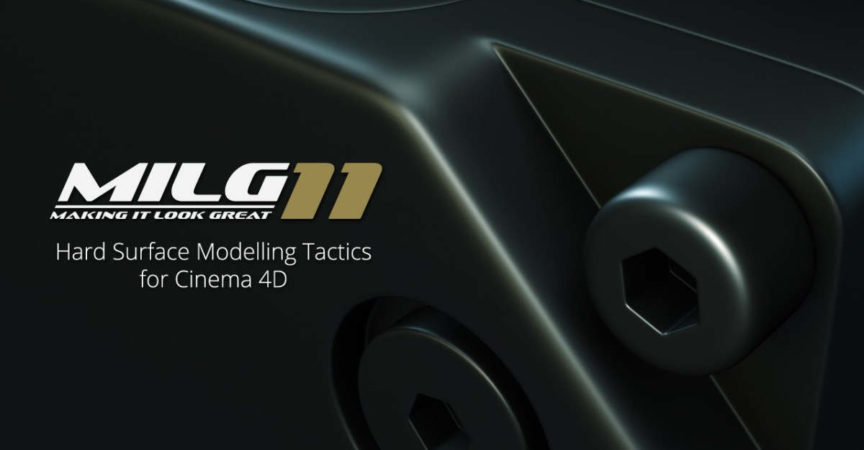MAKING IT LOOK GREAT 11 Hard Surface Modelling Tactics For Cinema 4D
Release date:2019
Author:Toby Pitman
Skill level:Beginner
Language:English
Exercise files:Yes
Of all the areas a 3D artist can learn, modelling is arguably the most difficult to master. It takes hours, weeks, months and years of practice and mistake making to reach the stage where you can decipher a mesh just by looking at it. Also, finding thorough training that focusses on more than just a few techniques and tools isn’t easy, especially if you’re a Cinema 4D artist. Mastering modelling in Cinema 4D has generally relied on finding what tutorials you can for Cinema 4D, then moving on to Maya and Max tutorials to fill the void. With MILG11: Hard Surface Modelling Tactics for Cinema 4D this is no longer the case. MILG11 is the missing link in Cinema 4D modelling, developed specifically for Cinema 4D artists and covering everything you need to know from fundamental modelling concepts to hidden features of key modelling tools. If you’re serious about learning modelling in Cinema 4D, MILG 11: Hard Surface Modelling Tactics for Cinema 4D is the ideal place to start. Here’s what’s included:
Geometry Basics
Important, fundamental geometry concepts that are the foundation to correct modelling.
Directing Flow: Quad workflow and its importance in maintaining predictable edge flow.
Redirecting Flow: Tools and techniques for redirecting edge flow.
Edge Loops: The importance of loops in edge flow, adding and
encapsulating detail.
Normals: The importance of Surface and Vertex Normals to modelling, materials and rendering.
Using Diamonds: Using diamond quads to split edge flow and control edge count.
Key Tools
Key tools and concepts to save time, model correctly and create seemingly complex meshes with ease.
The Slide Tool: Tips and tricks for working with the Slide Tool.
Symmetry: Time saving techniques using the Symmetry Object.
Radial Symmetry: Time saving techniques using radial symmetry.
Modelling Axis Tools: Tips and tricks for using the Modelling Axis Tools.
Shrink Wrapping: Projecting a mesh using the Shrink Wrap Deformer.
Subdivision Basics
Understanding polygonal subdivision and how it relates to hard surface modelling.
Splines Vs Subdivision: The benefits of subdivision modelling over a spline-based workflow.
Basic Curvature: Understanding polygon count and its importance in creating smooth curvature.
Edge Sharpening: Tips and techniques for cutting transitional edges on geometry under subdivision.
Convex Cuts: Tips and techniques for creating sharp, convex details in geometry under subdivision.
Concave Cuts: Tips and techniques for adding sharpening to concave details under subdivision.
Isolating Cuts: Techniques for isolating cuts to extruded, internal geometry.
Uprezing a Mesh: Adding detail into a specific part of a mesh without affecting other geometry.
Cylindrical Detail: Adding detail to cylindrical objects under subdivision without affecting curvature.
Surface Tension: Understanding subdivision surface tension and how it affects geometry.
Topology Tactics
Techniques, tactics and drills for a 2D workflow that greatly simplifies the modelling process.
Simple Shapes: Resolving simple shapes in geometry using a 2D topology workflow.
Tech Shapes: Tech shape drills with templates and time-lapse solutions.
Reshaping With Deformers: Strategies for re-approaching topology to work with deformers.
Contour Lines: Adding transitional edges to pre-existing geometry.
Simple Bracket: Using a 2D topology workflow to build a bracket.
Surface Detail: Retopologising pre-existing geometry to add surface features and details.
Telecaster Scratchplate: Using a 2D topology workflow to build a Fender Telecaster scratchplate.
Engine Cover: Using a 2D topology workflow to build a motorcycle engine cover.
Repurposing Objects: Repurposing an existing object by modifying the topology.
Basic Retopology: Using the Polygon Pen Tool to retopologise existing geometry.
General Modelling Tactics
Vital modelling concepts, strategies and workflows.
Using Reference: The importance of having good references before commencing a model.
Blocking: The importance of blocking before commencing a complex model.
Details & Kit Bashing: Demystifying detailed models and the benefits of building a library.
Loop Strategies: Strategies for using loops to add edges and detail into existing geometry.
Complex Extruded Shapes: Creating complex extruded shapes and reconciling edge count to combine with existing geometry.
Boolean Strategies: The correct approach to including Booleans into a modelling workflow.
Modelling Walkthroughs
Intense, long form modelling workshops for creating a variety of challenging objects from scratch.
Tumbler: Step-by-step techniques for creating a glass tumbler.
Oil Pump: Step-by-step techniques for creating an oil pump.
MD90: Step-by-step techniques for creating an MD90 camera.
Bottle Opener: Step-by-step techniques for creating a bottle opener with corkscrew.
Rifle Stock: Step-by-step techniques for creating a rifle stock.
Bonus Tutorials
Handy bonus tips and techniques plus a little extra review.
Cylinder Holes: A variety of techniques for adding holes to cylinders.
USB Sharpening: Sharpening walkthrough of the USB port created in Symmetry.
Pipe Holder: Using a 2D topology workflow to create a simple pipe holder.





 Channel
Channel






Thanks for the videos! However it is missing a couple of parts from the end of section 03
Isolating Cuts
Uprezing a Mesh
Cylindrical Detail
Surface Tension
fixed already, my bad!
Missing
Subdivison Basics:
Isolating Cuts: Techniques for isolating cuts to extruded, internal geometry.
Uprezing a Mesh: Adding detail into a specific part of a mesh without affecting other geometry.
Cylindrical Detail: Adding detail to cylindrical objects under subdivision without affecting curvature.
Surface Tension: Understanding subdivision surface tension and how it affects geometry.
All that we have is here.
Sorry, I have checked again. And found that I forget to add 03_SubdivisionBasics_02 section to an article.
It is fixed now.
Can you please add this to the HelloLuxx Section?
Could you add Spanish subtitles?
Hello my friend Strawberry, Could you get this course?
https://blender-secrets-school.teachable.com/p/hard-surface-blender